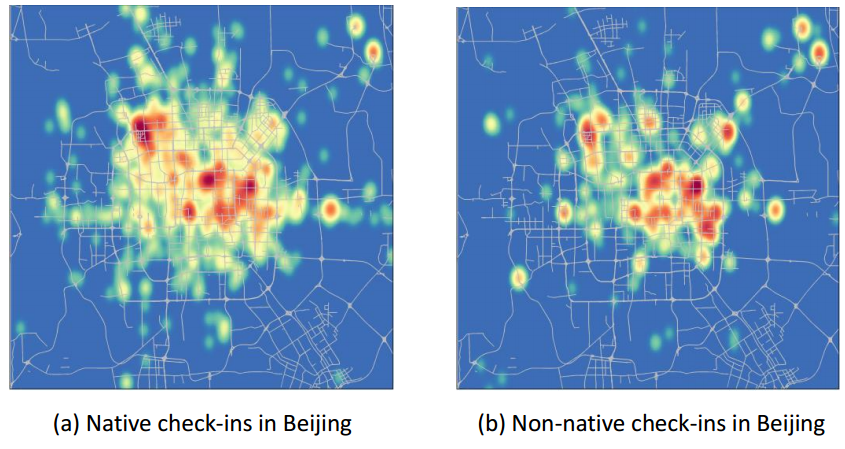The Emerging Science of Computational Anthropology
The increasing availability of big data from mobile phones and location-based apps has triggered a revolution in the understanding of human mobility patterns. This data shows the ebb and flow of the daily commute in and out of cities, the pattern of travel around the world and even how disease can spread through cities via their transport systems.

So there is considerable interest in looking more closely at human mobility patterns to see just how well it can be predicted and how these predictions might be used in everything from disease control and city planning to traffic forecasting and location-based advertising.
Today we get an insight into the kind of detailed that is possible thanks to the work of Zimo Yang at Microsoft research in Beijing and a few pals. These guys start with the hypothesis that people who live in a city have a pattern of mobility that is significantly different from those who are merely visiting. By dividing travelers into locals and non-locals, their ability to predict where people are likely to visit dramatically improves.
Zimo and co begin with data from a Chinese location-based social network called Jiepang.com. This is similar to Foursquare in the U.S. It allows users to record the places they visit and to connect with friends at these locations and to find others with similar interests.
The data points are known as check-ins and the team downloaded more than 1.3 million of them from five big cities in China: Beijing, Shanghai, Nanjing, Chengdu and Hong Kong. They then used 90 per cent of the data to train their algorithms and the remaining 10 per cent to test it. The Jiapang data includes the users’ hometowns so it’s easy to see whether an individual is checking in in their own city or somewhere else.
The question that Zimo and co want to answer is the following: given a particular user and their current location, where are they most likely to visit in the near future? In practice, that means analyzing the user’s data, such as their hometown and the locations recently visited, and coming up with a list of other locations that they are likely to visit based on the type of people who visited these locations in the past.
Zimo and co used their training dataset to learn the mobility pattern of locals and non-locals and the popularity of the locations they visited. The team then applied this to the test dataset to see whether their algorithm was able to predict where locals and non-locals were likely to visit.
They found that their best results came from analyzing the pattern of behavior of a particular individual and estimating the extent to which this person behaves like a local. That produced a weighting called the indigenization coefficient that the researchers could then use to determine the mobility patterns this person was likely to follow in future.
In fact, Zimo and co say they can spot non-locals in this way without even knowing their home location. “Because non-natives tend to visit popular locations, like the Imperial Palace in Beijing and the Bund in Shanghai, while natives usually check in around their homes and workplaces,” they add.
The team say this approach considerably outperforms the mixed algorithms that use only individual visiting history and location popularity. “To our surprise, a hybrid algorithm weighted by the indigenization coefficients outperforms the mixed algorithm accounting for additional demographical information.”
It’s easy to imagine how such an algorithm might be useful for businesses who want to target certain types of travelers or local people. But there is a more interesting application too.
Zimo and co say that it is possible to monitor the way an individual’s mobility patterns change over time. So if a person moves to a new city, it should be possible to see how long it takes them to settle in.
One way of measuring this is in their mobility patterns: whether they are more like those of a local or a non-local. “We may be able to estimate whether a non-native person will behave like a native person after a time period and if so, how long in average a person takes to become a native-like one,” say Zimo and co.
That could have a fascinating impact on the way anthropologists study migration and the way immigrants become part of a local community. This is computational anthropology a science that is clearly in its early stages but one that has huge potential for the future.
Ref: arxiv.org/abs/1405.7769 : Indigenization of Urban Mobility
Keep Reading
Most Popular
Large language models can do jaw-dropping things. But nobody knows exactly why.
And that's a problem. Figuring it out is one of the biggest scientific puzzles of our time and a crucial step towards controlling more powerful future models.
The problem with plug-in hybrids? Their drivers.
Plug-in hybrids are often sold as a transition to EVs, but new data from Europe shows we’re still underestimating the emissions they produce.
How scientists traced a mysterious covid case back to six toilets
When wastewater surveillance turns into a hunt for a single infected individual, the ethics get tricky.
Google DeepMind’s new generative model makes Super Mario–like games from scratch
Genie learns how to control games by watching hours and hours of video. It could help train next-gen robots too.
Stay connected
Get the latest updates from
MIT Technology Review
Discover special offers, top stories, upcoming events, and more.